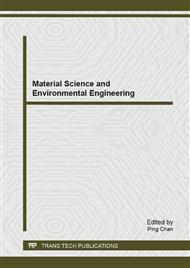[1]
A. Baker, Land use and water quality, J. Encyclopedia of Hydrological Sciences. 17 (2005) 2499-2501.
Google Scholar
[2]
R.S. Wu and D.A. Haith, Land use, climate, and water supply, J. Journal of Water Resources Planning and Management. 119 (1993) 685-704.
DOI: 10.1061/(asce)0733-9496(1993)119:6(685)
Google Scholar
[3]
S.A. Changnon and M. Demissie, Detection of changes in streamflow and floods resulting from climate fluctuations and land use-drainage changes, J. Climatic change. 32 (1996) 411-421.
DOI: 10.1007/bf00140354
Google Scholar
[4]
Mander, A. Kull, V. Tamm, et al, Impact of climatic fluctuations and land use change on runoff and nutrient losses in rural landscapes, J. Landscape and Urban Planning. 41 (1998) 229-238.
DOI: 10.1016/s0169-2046(98)00061-9
Google Scholar
[5]
A. Collins, D. Walling, L. Webb, et al, Apportioning catchment scale sediment sources using a modified composite fingerprinting technique incorporating property weightings and prior information, J. Geoderma. 155 (2010) 249-261.
DOI: 10.1016/j.geoderma.2009.12.008
Google Scholar
[6]
D.J. Ballantine, D.E. Walling, A.L. Collins, et al, The phosphorus content of fluvial suspended sediment in three lowland groundwater-dominated catchments, J. Journal of hydrology. 357 (2008) 140-151.
DOI: 10.1016/j.jhydrol.2008.05.011
Google Scholar
[7]
R.C. Sidle, T. Hirano, T. Gomi, et al, Hortonian overland flow from Japanese forest plantations—an aberration, the real thing, or something in between?, J. Hydrological Processes. 21 (2007) 3237-3247.
DOI: 10.1002/hyp.6876
Google Scholar
[8]
D.E. Walling, P.N. Owens and G.J. Leeks, Fingerprinting suspended sediment sources in the catchment of the River Ouse, Yorkshire, UK, J. Hydrological Processes. 13 (1999) 955-975.
DOI: 10.1002/(sici)1099-1085(199905)13:7<955::aid-hyp784>3.0.co;2-g
Google Scholar
[9]
M. Russell, D. Walling and R. Hodgkinson, Suspended sediment sources in two small lowland agricultural catchments in the UK, J. Journal of Hydrology. 252 (2001) 1-24.
DOI: 10.1016/s0022-1694(01)00388-2
Google Scholar
[10]
D.J. Nicholls. The source and behaviour of fine sediment deposits in the river Torridge, Devon and their implications for salmon spawning [D]; University of Exeter, (2000).
Google Scholar
[11]
A.L. Collins, D. Walling and G. Leeks, Composite fingerprinting of the spatial source of fluvial suspended sediment: a case study of the Exe and Severn River basins, United Kingdom, J. Géomorphologie: relief, processus, environnement. 2 (1996).
DOI: 10.3406/morfo.1996.877
Google Scholar
[12]
J. Motha, P. Wallbrink, P. Hairsine, et al, Determining the sources of suspended sediment in a forested catchment in southeastern Australia, J. Water resources research. 39 (2003) ESG2. 1-2. 14.
DOI: 10.1029/2001wr000794
Google Scholar
[13]
D. Walling, Tracing suspended sediment sources in catchments and river systems, J. Science of the total environment. 344 (2005) 159-184.
DOI: 10.1016/j.scitotenv.2005.02.011
Google Scholar
[14]
H. Li, X. Liu and W. Huang, The non-point output of different landuse types in Zhexi hydraulic rigion of Taihu Basin, J. Acta Geographica Sinica In Chinese. 59 (2004) 401-408.
DOI: 10.1007/bf02837530
Google Scholar
[15]
J. Carter, P.N. Owens, D.E. Walling, et al, Fingerprinting suspended sediment sources in a large urban river system, J. Science of the total environment. 314 (2003) 513-534.
DOI: 10.1016/s0048-9697(03)00071-8
Google Scholar
[16]
H. Dong, Z. Qiang, T. Li, et al, Analysis of the spatial-temporal variation of water quality in JinXi River, a tributary of Southern Tiaoxi River, J. Chinese Journal of Environmental Engineering. 6 (2012) 772-778.
Google Scholar
[17]
D. Walling, A. Collins and R. Stroud, Tracing suspended sediment and particulate phosphorus sources in catchments, J. Journal of Hydrology. 350 (2008) 274-289.
DOI: 10.1016/j.jhydrol.2007.10.047
Google Scholar
[18]
L.M. Svendsen, B. Kronvang, P. Kristensen, et al, Dynamics of phosphorus compounds in a lowland river system: Importance of retention and non‐point sources, J. Hydrological Processes. 9 (1995) 119-142.
DOI: 10.1002/hyp.3360090202
Google Scholar


